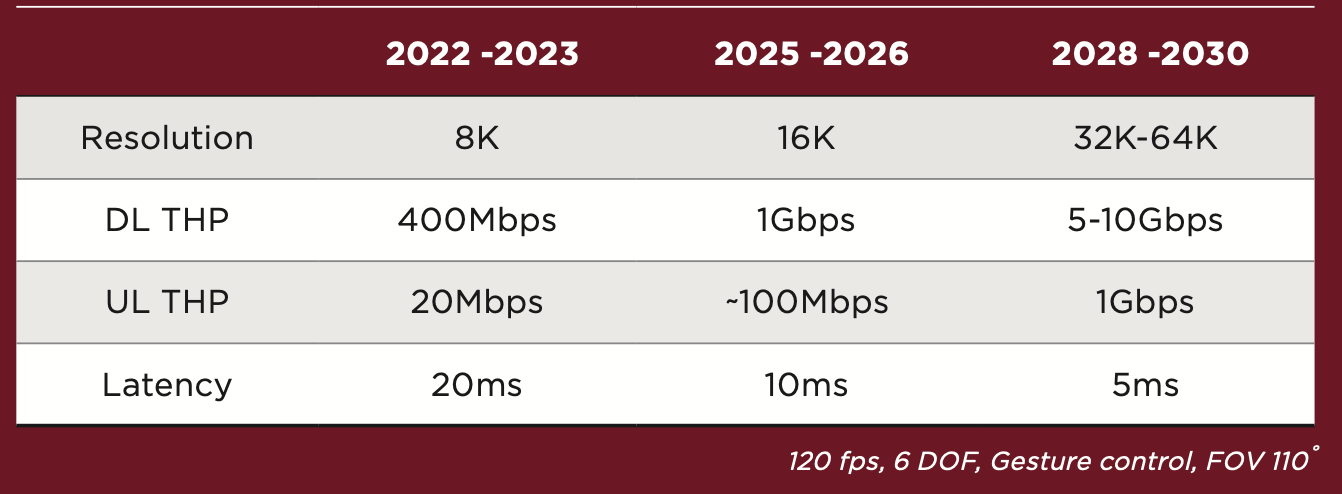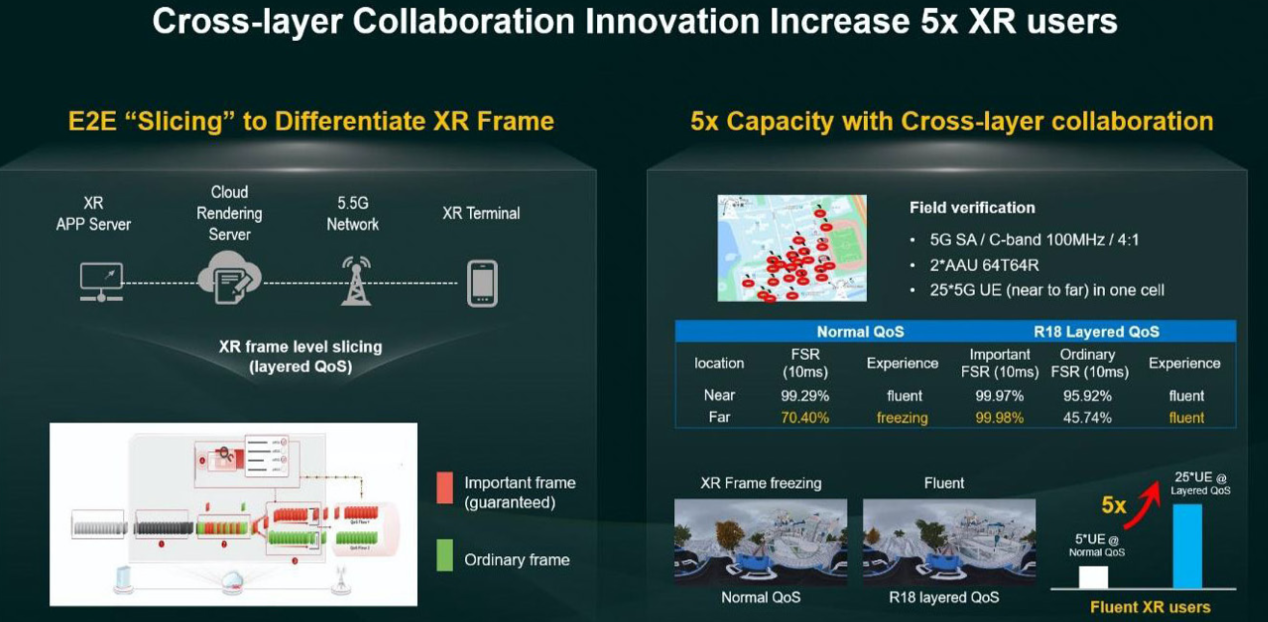5G Transformation Hub
5G-Advanced Promises Step Change for Extended Reality
Cross-layer collaboration tech could enable fivefold increase in simultaneous XR users
Tests of 5G-Advanced cross-layer collaboration technology have demonstrated that forthcoming cellular networks will be able to deliver highly immersive extended reality (XR) experiences. Conducted in Hangzhou, Zhejiang province, China, the tests explored how 5G-Advanced networks could support very high-resolution virtual environments generated by computer technologies and wearable devices.
Select a project
Contents
Challenge
The transmission of XR services can put great demands on wireless networks in terms of capacity and stability. Today, a 5G network cell can support five to 10 users simultaneously streaming XR video in 4K resolution at 60 frames per second (the throughput per user is about 70 Mbps). But Huawei believes, in future, fully immersive experiences will require XR videos in 16K to 24K resolution at 120 frames per second, so the transmission rate required by a single user will need to rise to between 1 Gbps and 10 Gbps in the medium term. In addition, interactive video services need a very responsive and robust network connection to resist signal fluctuation, to provide the user with a compelling experience, particularly if they are at the edge of the cell.
Solution
In the second quarter of 2022, Huawei and China Mobile tested a prototype 5G-Advanced network that uses cross-layer collaboration technology to ensure the most important frames in XR video streams are transmitted with the highest priority. That will enable mobile operators to provide more users with fully immersive experiences with the same cell capacity. 5G-Advanced will further support large-bandwidth spectrum and extremely large aperture array massive MIMO, which will allow the network to deliver 10 Gbps and vey low latency connectivity, according to Huawei.
Impact & Statistics
Huawei says the tests in Hangzhou demonstrated that 5G-Advanced cross-layer collaboration technology can increase the number of satisfied XR users fivefold with the same cell capacity. That could accelerate the development of advanced XR services in many fields, including gaming, culture, travel, education, and industrial diagnostics, and help the Metaverse to go mainstream. Global shipments of XR devices are set to grow almost tenfold from 11 million units in 2021 to 105 million units in 2025, according to research firm Counterpoint.
Wider Implications
Supported by sufficiently robust connectivity and XR applications, the virtual worlds that make up the Metaverse could become highly convenient places to interact and transact. Ultimately, 5G-Advanced could support multimodal XR that provides users with tactile experiences, as well as video and audio streams. In the consumer market, XR applications are likely to gradually expand from indoor home entertainment (movies, live broadcast and games) to outdoor in-car XR entertainment and AR navigation. In the business market, there could be a gradual shift from XR education and training to XR holographic conferences and collaboration. Huawei and CMCC plan to test how well 5G-Advanced networks sill support XR services in outdoor scenarios, such as inside vehicles.
Stakeholders
Huawei, CMCC (China Mobile Communications Group Co., Ltd.)
02
5G-Advanced Promises to Enrich Extended Reality
Cross-layer collaboration tech could enable a fivefold increase in simultaneous XR users
Demand for virtual reality and augmented reality applications is growing steadily. But the transmission of these extended reality (XR) services can put major demands on wireless networks’ capacity and stability.
Today, a 5G network cell can
support five to 10 users
simultaneously streaming XR
video in 4K resolution at 60
frames per second (the
throughput per user is about 70
Mbps), according to Huawei.
But the equipment vendor
believes that fully immersive
experiences will ultimately require
XR videos in 16K to 24K resolu-
tion at 120 frames per second, so
the transmission rate required by
a single user will need to rise to
between 1 Gbps and 10 Gbps in
the medium term.
XR services also need low latency connectivity. Huawei estimates the two-way transmission of “motion to photon” should not exceed 20ms and will need to fall further in future (see chart).
At the same time, interactive video services need a very responsive and robust network connection to resist signal fluctuation and provide the user with a compelling experience, particularly if they are at the edge of the cell. Therefore, breakthroughs in wireless technologies are required to address both user experience and capacity challenges.
In the second quarter of 2022, “China Mobile and Huawei jointly completed the industry’s first cross-layer integration test,” says Ding Haiyu, Vice Director of China Mobile Research Institute.
“The test results show that a single sector with a 100 MHz bandwidth of 4.9 GHz can support 20 XR terminals at the same time, increasing the system capacity by five times. It is estimated that by 2025, the value of VR software applications will reach US$35 billion, and the number of active VR head display devices worldwide will reach 70 million. However, the current 5G network cannot meet the latency requirements of 100 Mbps and 5 ms, let alone the speed of the future metaverse as high as 10 Gbps, and the low latency requirements of milliseconds. Network capacity has become a bottleneck hindering the development of the metaverse.”
Huawei says the tests in Hangzhou demonstrated that 5G-Advanced cross-layer collaboration technol- ogy can increase the number of satisfied XR users fivefold with the same cell capacity.
5G-Advanced networks will also benefit from large-bandwidth spectrum and extremely large ap- erture array massive MIMO, which could be combined to deliver throughput of up to 10 Gbps and very low latency connectivity, according to Huawei.
“The 5G-Advanced cross-layer collaboration solution solves XR end user experience problems and reduces network costs by 80%,” says John Gao, President of 5.5G Domain, Huawei.
That could accelerate the development of advanced XR services in many fields, including gaming, culture, travel, education, and industrial diagnostics, and help the Metaverse to go mainstream.
Global shipments of XR devices are set to grow almost tenfold from 11 million units in 2021 to 105 million units in 2025, according to research firm Counterpoint. Manufacturers of head mounted displays are also releasing products that can support 4K and 8K resolutions.
Supported by sufficiently robust connectivity and XR applications, the virtual worlds that make up the Metaverse could become highly convenient places to interact and transact. The Analysis Group, an economics consulting firm, has released a report suggesting that the Metaverse could make a US$3 trillion contribution to global GDP in 2031.
In the consumer market, XR
applications are likely to gradually
expand from indoor home
entertainment (movies, live
broadcast and games) to outdoor
in-car XR entertainment and
AR navigation. In the business
market, there could be a gradual
shift from XR education and
training to XR holographic
conferences and collaboration.
Ultimately, 5G-Advanced
networks could support
multimodal XR that provide users
with tactile experiences, as well
as video and audio streams.


John Gao
President of 5.5G Domain, Huawei

03
How cross-layer collaboration technology works
The cross-layer collaboration technology tested by Huawei and China Mobile facilitates interaction between the XR application server, the transport network, a 5.5G radio access network and the end-user device. For example, the service layer can sense the network status, and then adjust the content, size, and encoding bit rate of the data packets it is sending, accordingly.
At the same time, the network layer senses service information and then protects the integrity of service frames, while implementing differentiated scheduling of different data flows, with a view to providing an end-to-end frame-level quality of service (QoS) guarantee.
Using these techniques, the cross-layer collaboration technology can preferentially guarantee high-priority image frames. With an XR service, the first frame in a group of pictures (known as the I frame) contains the complete image and is the most important frame.
The following P frames (predicted frames) are encoded and decoded based on the I frame. By sensing the identification information at the service layer, a 5G-Advanced network can prioritise the I frames, discarding less important data when the network is congested to ensure the I frames gets through (see graphic).
During data transmission, each video frame is divided into multiple IP data packets. If one or more of these IP data packets are lost, decoding of the corresponding video frame will fail. By sensing frame integrity and frame-level QoS information, an Advanced-5G network could schedule data in a single frame at the same time or discard packets if necessary. For example, if an IP data packet is lost, other IP data packets belonging to the same video frame could be discarded, so as to avoid transmitting useless data, thereby saving network resources.
“Through these methods, the network can provide end-to-end frame-level QoS guarantee more effectively,” says John Gao.
Another key connectivity challenge for XR services is the fact that they depend on multiple types of information flow data, such as audio, video, control signals, and information collection signals. The service provider needs to coordinate the transmission of these multiple types of service flows to ensure that the time difference between the service flows and the terminal side is within the acceptable range.
The cross-layer collaboration technology is designed to support synchronous transmission of multiple streams. “By sensing data flow information at the XR application layer, the Advanced-5G network maps data flows with different QoS requirements to different QoS flows by using hierarchical QoS mapping, and combine differentiated scheduling, multi-QoS flow association and collaboration, and multi-QoS flow synchronisation enhancement,” explains John Gao. “The eNodeB (the base station) performs more refined scheduling and transmission for XR services to further improve the user experience of XR services.”
With a conventional 5G network, the minimum granularity for QoS
assurance is QoS flows, according to Huawei, which means packets with
different priorities in the same QoS flow cannot be identified
and differentiated.


John Gao
President of 5.5G Domain, Huawei

04
Extended reality services could be used across the economy
XR services could improve productivity and convenience for consumers, enterprises and public institutions in a wide variety of application areas, such as entertainment, training, education, remote support, remote control, communications and virtual meetings. They could be used in virtually all industry segments, including healthcare, real estate, shopping, transportation and manufacturing. VR is already used for gaming both at home and at dedicated venues, for virtual tours of real estate, for education and training purposes and for remote participation at live events, such as concerts and sports.
Huawei and China Mobile plan to test how well 5G-Advanced networks will support XR services in outdoor scenarios, such as inside vehicles, where cellular networks are the only realistic connectivity option. “Fixed broadband and Wi-Fi cannot be used in a wide range of geographical and mobile scenarios,” notes John Gao. “Therefore, 5G-Advanced will be the inevitable choice for XR application explosion.”
China Mobile and Huawei will continue to work with industry partners, such as chip providers, device vendors and content developers, in a number of ways. They plan, for example, to further refine the network requirements of different Metaverse service scenarios, while exploring how 5G-Advanced technologies can support XR services in the consumer and business markets, underpinned by sustainable business models for each player in the value chain.
“As we know, 5G drives the development of video services towards HD and immersive. From HD/4K, cloud gaming, VR/AR, to more immersive metaverse requirements, new business forms are constantly developing, which brings new requirements to network and computing infrastructure,” concludes Huang Yuhong, General Manager of China Mobile Research Institute.
“The requirements of ultra-low latency, ultra-large bandwidth, super virtual-real-time synchronization, and ultra-real- time interaction in the Metaverse bring unprecedented challenges and are also an important driving force for infrastructure development.”


Jim Kiles
President of 5.5G Domain, Huawei
About the GSMA
The GSMA is a global organisation unifying the mobile ecosystem to discover, develop and deliver innovation foundational to positive business environments and societal change. Our vision is to unlock the full power of connectivity so that people, industry, and society thrive. Representing mobile operators and organisations across the mobile ecosystem and adjacent industries, the GSMA delivers for its members across three broad pillars: Connectivity for Good, Industry Services and Solutions, and Outreach. This activity includes advancing policy, tackling today’s biggest societal challenges, underpinning the technology and interoperability that make mobile work, and providing the world’s largest platform to convene the mobile ecosystem at the MWC and M360 series of events.
For more information, please visit the GSMA corporate website at www.gsma.com.
Follow the GSMA on Twitter: @GSMA.
GSMA 5G Transformation Hub
The GSMA 5G Transformation Hub is an authoritative source of information on some of the most innovative 5G solutions in the world. This portal contains case studies detailing design, benefits, key players, measured value and the future impact of scaling up these 5G solutions worldwide. The 5G Era is now firmly established and this family of standardised GSM technologies, including mmWave, are being rolled out successfully across the globe. The GSMA 5G Transformation Hub, launched at MWC Barcelona in 2022, provides details of how 5G is best placed to deliver real value for a range of key sectors including manufacturing, energy, transportation, live entertainment, smart cities and construction. We acknowledge the kind support and sponsorship of Qualcomm Technologies with the creation of this case study.
Many more case studies will be added, in the coming months, covering even more industries and the GSMA is asking Members to nominate innovative 5G case studies to add to this global digital showcase.